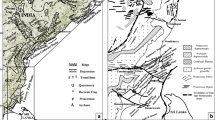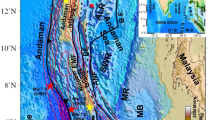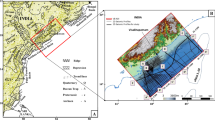Abstract
The southwestern continental margin of India reveals the presence of an anomalous bathymetric high feature located in the mid-continental slope region off Trivandrum. Based on the analysis of the available geophysical data and plate tectonic reconstruction, this feature was interpreted as a scar of India-Madagascar separation, with its conjugate identified on the Northern Madagascar Ridge. Although the conjugate nature of the Alleppey-Trivandrum Terrace Complex and the Northern Madagascar Ridge was postulated, this inference has not yet been evaluated by comparing their geophysical signatures and crustal structure. The present study is aimed to derive and compare the crustal configuration of these two features using an up-to-date compilation of the bathymetry, gravity and magnetic data, and by employing integrated forward modelling of gravity and magnetic anomalies. Our derived crustal models for the Alleppey-Trivandrum Terrace Complex and the Northern Madagascar Ridge suggest that both these features can be explained in terms of thinned continental crust intermingled with volcanic intrusives. The crustal thicknesses of the Northern Madagascar Ridge and Alleppey-Trivandrum Terrace Complex at their conjugate continent-ocean boundaries are ~ 17 km and both these features are associated with high amplitude magnetic anomalies whose genesis is attributed to the volcanism caused by the Marion hotspot activity. Therefore, based on our integrated interpretation of the geophysical data, we support the earlier interpretation on conjugate nature of the Northern Madagascar Ridge and the Alleppey-Trivandrum Terrace Complex that was proposed based on the fitting of shape and size of the bathymetric notch observed in the southeastern continental margin of Madagascar with a bathymetric protrusion observed in the southwestern continental margin of India in the India-Madagascar pre-drift scenario. These features remained as a single unit prior to ~ 88 Ma and subsequently got separated during the India-Madagascar breakup.










Similar content being viewed by others
Data Availability
Datasets generated during the current study are confidential and is deposited at the Marine Geoscientific database being managed by NCPOR.
Code Availability
Not applicable.
References
Anilkumar, Pande K, Venkatesan TR, Rao YJB (2001) The Karnataka Late Cretaceous Dykes as products of the Marion Hot Spot at the Madagascar - India Breakup Event: Evidence from 40Ar-39Ar geochronology and geochemistry. Geophys Res Lett 28:2715–2718. https://doi.org/10.1029/2001GL013007
Bhattacharya GC, Yatheesh V (2015) Plate-tectonic evolution of the deep ocean basins adjoining the western continental margin of India - A proposed model for the early opening scenario. In: Mukherjee J (ed) Petroleum Geoscience: Indian Contexts. Springer International Publishing, pp 1–61
Bijesh CM, John Kurian P, Yatheesh V et al (2018) Morphotectonic characteristics, distribution and probable genesis of bathymetric highs off southwest coast of India. Geomorphology 315:33–44. https://doi.org/10.1016/j.geomorph.2018.04.015
Brocher TM (2005) Empirical relations between elastic wavespeeds and density in the Earth’s crust. Bull Seismol Soc Am 95(6):2081–2092
Fowler CMR (2005) The Solid Earth: an Introduction to Global Geophysics. Cambridge University Press, Cambridge
GEBCO Compilation Group (2020) GEBCO 2020 Grid, doi:https://doi.org/10.5285/a29c5465-b138-234d-e053-6c86abc040b9
Goslin J, Recq M, Schlich R (1981) Structure profonde du plateau de Madagascar: relations avec le plateau de crozet. Tectonophysics 76:75–97
Goslin J, Segoufin J, Schlich R, Fisher RL (1980) Submarine topography and shallow structure of the Madagascar Ridge, Western Indian Ocean. GSA Bull 91:741–753
IOC-IHO-BODC (2003) Centenary Edition of the GEBCO Digital Atlas, published on CD-ROM on behalf of the Intergovernmental Oceanographic Commission and the International Hydrographic Organization as part of the General Bathymetric Chart of the Oceans. British Oceanographic Data Centre, Liverpool, UK
Leinweber VT, Klingelhoefer F, Neben S et al (2013) The crustal structure of the Central Mozambique continental margin - Wide-angle seismic, gravity and magnetic study in the Mozambique Channel, Eastern Africa. Tectonophysics 599:170–196. https://doi.org/10.1016/j.tecto.2013.04.015
Maus S, Barckhausen U, Berkenbosch H et al (2009) EMAG2: A 2–arc min resolution Earth Magnetic Anomaly Grid compiled from satellite, airborne, and marine magnetic measurements. Geochem Geophys Geosyst 10:Q08005. https://doi.org/10.1029/2009GC002471
Melluso L, Sheth HC, Mahoney JJ et al (2009) Correlations between silicic volcanic rocks of the St Mary’s Islands (southwestern India) and eastern Madagascar: implications for Late Cretaceous India–Madagascar reconstructions. J Geol Soc London 166:283–294. https://doi.org/10.1144/0016-76492007-147
Mohan MR, Shaji E, Satyanarayanan M et al (2016) The Ezhimala Igneous Complex, southern India: Possible imprint of Late Cretaceous magmatism within rift setting associated with India-Madagascar separation. J Asian Earth Sci 121:56–71. https://doi.org/10.1016/j.jseaes.2016.02.003
Nathaniel DM (2013) Hydrocarbon Potential of Sub-Basalt Mesozoics of Deepwater Kerala Basin, India. 10th Biennial International Conference & Exposition Kochi 2013, 1–7
Pande K, Sheth HC, Bhutani R (2001) 40Ar–39Ar age of the St. Mary’s Islands volcanics, southern India: record of India–Madagascar break-up on the Indian subcontinent. Earth Planet Sci Lett 193:39–46
Radhakrishna T, Dallmeyer RD, Joseph M (1994) Palaeomagnetism and 36Ar/40Ar vs. 39Ar/40Ar isotope correlation ages of dyke swarms in central Kerala, India: Tectonic implications. Earth Planet Sci Lett 121:213–226
Radhakrishna T, Joseph M (2012) Geochemistry and paleomagnetism of Late Cretaceous mafic dikes in Kerala, southwest coast of India in relation to large igneous provinces and mantle plumes in the Indian Ocean region. GSA Bull 124:240–255. https://doi.org/10.1130/B30288.1
Radhakrishna T, Maluski H, Mitchell JG, Joseph M (1999) 40Ar/39Ar and K/Ar geochronology of the dykes from the south Indian granulite terrain. Tectonophysics 304:109–129
Sandwell D, Müller D, Smith W et al (2014) New global marine gravity from CryoSat-2 and Jason-1 reveals buried tectonic structure. Science 346:65–67. https://doi.org/10.1126/science.1258213
Sheth H, Pande K, Vijayan A et al (2017) Recurrent Early Cretaceous, Indo-Madagascar (89–86 Ma) and Deccan (66 Ma) alkaline magmatism in the Sarnu-Dandali complex, Rajasthan: 40Ar/39Ar age evidence and geodynamic significance. Lithos 284–285:512–524
Shuhail M, Yatheesh V, Bhattacharya GC et al (2018) Formation and evolution of the Chain-Kairali Escarpment and the Vishnu Fracture Zone in the Western Indian Ocean. J Asian Earth Sci 164:307–321. https://doi.org/10.1016/j.jseaes.2018.06.022
Storey M, Mahoney JJ, Saunders AD et al (1995) Timing of hot spot-related volcanism and the breakup of Madagascar and India. Science 267:852–855. https://doi.org/10.1126/science.267.5199.852
Straume EO, Gaina C, Medvedev S et al (2019) GlobSed: Updated total sediment thickness in the World’s Oceans. Geochem Geophys Geosyst 20:1756–1772. https://doi.org/10.1029/2018GC008115
Talwani M, Heirtzler JR (1964) Computation ofmagnetic anomalies caused by two di- mensional structures of arbitrary shape. In: Parks GA (ed) Computers in the Mineral Industries. Stanford University, pp. 464–480
Talwani M, Worzel JL, Landisman M (1959) Rapid gravity computations for two-dimensional bodies with application to the Mendocino submarine fracture zone. J Geophys Res 64:49–59
Torsvik TH, Tucker RD, Ashwal LD et al (1998) Late Cretaceous magmatism in Madagascar: Palaeomagnetic evidence for a stationary Marion hotspot. Earth Planet Sci Lett 164:221–232. https://doi.org/10.1016/S0012-821X(98)00206-4
Torsvik TH, Tucker RD, Ashwal LD et al (2000) Late Cretaceous India–Madagascar fit and timing of break-up related magmatism. Terra Nova 12:220–224
Valsangkar AB, Radhakrishnamurthy C, Subbarao KV, And Beckinsale RD (1981) Palaeomagnetism and Potassium - Argon age studies of acid Igneous rocks from the St.Mary Islands. In: Subbarao KV, Sukeshwala RN (eds) Deccan Volcanism, vol 3. Mem. Geol. Soc. India, pp 265–276
Wessel P, Luis JF, Uieda L et al (2019) The Generic Mapping Tools Version 6. Geochem Geophys Geosyst 20:5556–5564
Yatheesh V (2020) Structure and tectonics of the continental margins of India and the adjacent deep ocean basins: Current status of knowledge and some unresolved problems. Episodes 43:586–608. https://doi.org/10.18814/epiiugs/2020/020039
Yatheesh V, Bhattacharya GC, Mahender K (2006) The terrace like feature in the mid-continental slope region off Trivandrum and a plausible model for India-Madagascar juxtaposition in immediate pre-drift scenario. Gondwana Res 10:179–185. https://doi.org/10.1016/j.gr.2005.11.021
Yatheesh V, Bhattacharya GC, Shuhail M (2020) Revised plate tectonic reconstruction model for the early opening of the Arabian Sea. In: Rossi P, François C, Miles P (eds) The Indian Ocean and its Margins. Commission for the Geological Map of the World, France, pp 11–12
Yatheesh V, Kurian PJ, Bhattacharya GC, Rajan S (2013) Morphotectonic architecture of an India-Madagascar breakup related anomalous submarine terrace complex on the southwest continental margin of India. Mar Pet Geol 46:304–318. https://doi.org/10.1016/j.marpetgeo.2013.07.005
Acknowledgements
The authors are grateful to Dr. M. Ravichandran, Director, National Centre for Polar and Ocean Research (NCPOR), Goa, and Prof. Sunil Kumar Singh, Director, CSIR-National Institute of Oceanography (CSIR- NIO), Goa, for their permission to publish the present work. This study forms a part of the PhD work of CMB at Goa University. We thank Dr. K.A. Kamesh Raju and Dr. G.N. Nayak for their constructive comments at various stages of the present work. We are indebted to two anonymous reviewers for their valuable comments, which helped us to improve the readability of the paper. We are grateful to Dr. Claudio Lo Iacono for the editorial handling of the manuscript. We thank the shipboard scientific party, officers and crew members of the MGS-03, MGS-04, and MGS-08 expeditions conducted onboard MGS Sagar, and SSD-059 expedition onboard RV Sindhu Sadhana, for extending their support. Directorate General of Hydrocarbons, New Delhi is thanked for providing the multichannel seismic reflection sections used in the present study. For plotting the figures presented in this paper, we used Generic Mapping Tools (GMT) software (Wessel et al. 2019). This is NCPOR contribution J-79/2021-22 and NIO contribution 6887.
Funding
Ministry of Earth Sciences (MoES), Government of India provided the financial support to carry out the work through the ‘Geoscientific Studies of Exclusive Economic Zone of India’ Programme under grant no. MoES/EFC/28/2018-PC-II.
Author information
Authors and Affiliations
Corresponding author
Ethics declarations
Conflict of interest
The authors declare no competing interests.
Ethics approval
Not Applicable.
Consent to participate
Not Applicable.
Consent for publication
Certified that all authors have seen and approved the final version of the manuscript being submitted.
Additional information
Publisher’s Note
Springer Nature remains neutral with regard to jurisdictional claims in published maps and institutional affiliations.
Rights and permissions
About this article
Cite this article
Bijesh, C.M., Yatheesh, V., Kurian, P.J. et al. Conjugate nature of the Alleppey-Trivandrum Terrace Complex with the Northern Madagascar Ridge in the early opening model of the Arabian Sea: evaluation based on an integrated geophysical investigation. Mar Geophys Res 43, 14 (2022). https://doi.org/10.1007/s11001-022-09469-x
Received:
Revised:
Accepted:
Published:
DOI: https://doi.org/10.1007/s11001-022-09469-x




